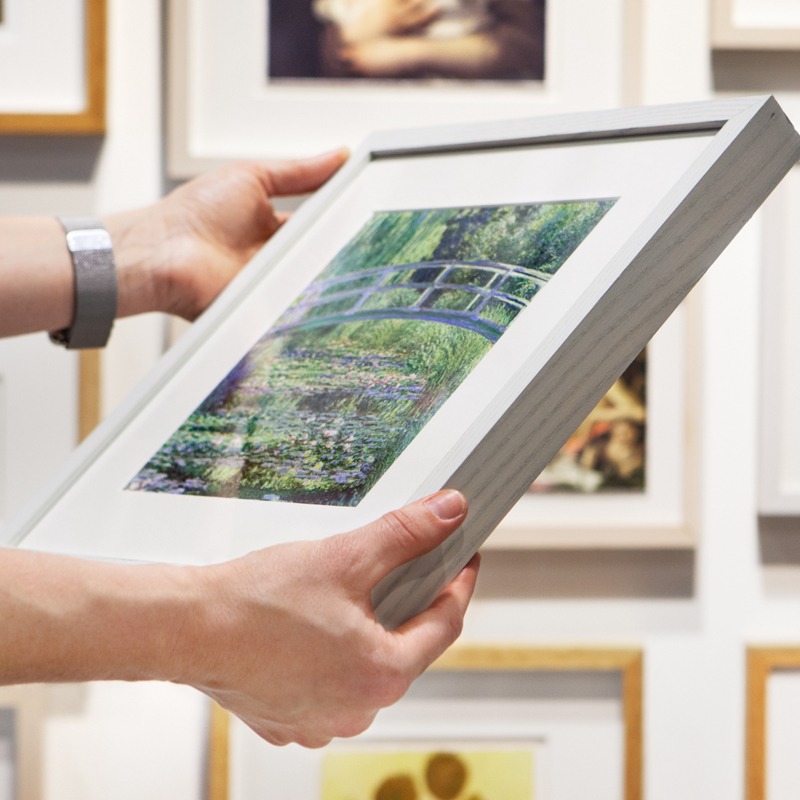Claude Monet, 'The Gare St-Lazare', 1877
About the work
Overview
This painting is one of a dozen views of the Gare Saint-Lazare that Monet painted in early 1877. He had known the station since his childhood, and it was also the terminal for trains to many of the key Impressionist sites west of Paris.
One of the less finished paintings of the group, it is the most freely painted of the four pictures Monet made within the station itself. He positioned himself at the terminus of one of the main lines, looking across the platforms. In the foreground two locomotives are swathed in steam and surrounded by passengers probably waiting to board.
The dark angular lines of the roof’s girders contrast with the random patterns formed by the vapour and smoke. By including the closed roof at the top of the picture, Monet has turned the conventions of landscape upside down – the light and clouds associated with an open sky are contained inside a distinctly modern structure made of glass and iron.
Key facts
Details
- Full title
- The Gare St-Lazare
- Artist
- Claude Monet
- Artist dates
- 1840 - 1926
- Date made
- 1877
- Medium and support
- oil on canvas
- Dimensions
- 54.3 × 73.6 cm
- Inscription summary
- Signed
- Acquisition credit
- Bought, 1982
- Inventory number
- NG6479
- Location
- Room 41
- Collection
- Main Collection
- Frame
- 20th-century Replica Frame
Provenance
Additional information
Text extracted from the National Gallery’s Annual Report, ‘The National Gallery Report: January 1982 – December 1984’ and supplemented by Isobel Muir.
Exhibition history
-
2008Art in the Age of Steam: Europe, America and the Railway, 1830-1960Walker Art Gallery18 April 2008 - 10 August 2008The Nelson-Atkins Museum of Art13 September 2008 - 18 January 2009
-
2013Clouds: Fleeting WorldsLeopold Museum22 March 2013 - 1 July 2013
-
2018The Credit Suisse Exhibition: Monet & ArchitectureThe National Gallery (London)9 April 2018 - 29 July 2018
-
2019The Courtauld Collection. A Vision for ImpressionismFondation Louis Vuitton20 February 2019 - 17 June 2019
-
2019Monet: PlacesMuseum Barberini29 February 2020 - 19 July 2020
-
2021Tracks to ModernityRoyal Museums of Fine Arts of Belgium15 October 2021 - 13 February 2022
Bibliography
-
1910P. Fechter, 'Die Sammlung Oscar Schmitz', Kunst und Künstler, VIII, 1910, pp. 15-25
-
1920K. Scheffler, 'Die Sammlung O.Schmitz in Dresden', Kunst und Künstler, 1920, pp. 186
-
1926M. Dormoy, 'La Collection Schmitz à Dresde', L'Amour de l'Art, 10, 1926, pp. 339-43
-
1928P. Wescher, 'Review: Thannhauser Exhibition', Pantheon, 1928
-
1928W. Wolfradt, 'Monet und der Impressionismus. Zu den Ausstellungen der Berliner Galerien Thannhauser und Goldschmidt and Co', Cicerone, I, 1928
-
1948O. Reuterswärd, Monet, Stockholm 1948
-
1954D. Cooper, The Courtauld Collection: A Catalogue and Introduction, London 1954
-
1954Marlborough Fine Art, Claude Monet 1840-1926: Exhibition in Aid of the British Empire Cancer Campaign (exh. cat., Marlborough Fine Art, 14 June 1954 - 30 July 1954), London 1954
-
1960W.C. Seitz, Claude Monet, London 1960
-
1974D. Wildenstein, Claude Monet: Biographie et catalogue raisonné, 4 vols, Lausanne 1974
-
1978J. Isaacson, Observation and Reflection: Claude Monet, Oxford 1978
-
1981G. Seiberling, Monet's Series, New York 1981
-
1985National Gallery, The National Gallery Report: January 1982 - December 1984, London 1985
-
1985A. Roy, 'The Palettes of Three Impressionist Paintings', National Gallery Technical Bulletin, IX, 1985, pp. 12-20
-
1986J. House, Monet: Nature into Art, New Haven 1986
-
1990D. Bomford, R. White and L. Williams, Impressionism (exh. cat. The National Gallery, 1990), London 1990
-
1992V. Spate, The Colour of Time: Claude Monet, London 1992
-
1993R. White and J. Pilc, 'Analyses of Paint Media', National Gallery Technical Bulletin, XIV, 1993, pp. 86-94
-
1994J. House, Impressionisim for England: Samuel Courtauld as Patron and Collector, London 1994
-
1995P.H. Tucker, Claude Monet: Life and Art, New Haven 1995
-
1996D. Wildenstein, Claude Monet. Catalogue raisonné, Cologne 1996
-
1996S. Koja, Claude Monet (exh. cat. Österreichische Galerie Belvedere, 13 March - 16 June 1996), Munich 1996
-
2001
C. Baker and T. Henry, The National Gallery: Complete Illustrated Catalogue, London 2001
-
2003J. Geskó (ed.), Monet et ses amis (exh. cat., Szépművészeti Múzeum, 1 December 2003 - 15 March 2004), Budapest 2003
About this record
If you know more about this work or have spotted an error, please contact us. Please note that exhibition histories are listed from 2009 onwards. Bibliographies may not be complete; more comprehensive information is available in the National Gallery Library.




















